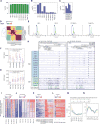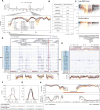Cerebral Organoids Recapitulate Epigenomic Signatures of the Human Fetal Brain
- PMID: 28009303
- PMCID: PMC5495578
- DOI: 10.1016/j.celrep.2016.12.001
Cerebral Organoids Recapitulate Epigenomic Signatures of the Human Fetal Brain
Abstract
Organoids derived from human pluripotent stem cells recapitulate the early three-dimensional organization of the human brain, but whether they establish the epigenomic and transcriptional programs essential for brain development is unknown. We compared epigenomic and regulatory features in cerebral organoids and human fetal brain, using genome-wide, base resolution DNA methylome and transcriptome sequencing. Transcriptomic dynamics in organoids faithfully modeled gene expression trajectories in early-to-mid human fetal brains. We found that early non-CG methylation accumulation at super-enhancers in both fetal brain and organoids marks forthcoming transcriptional repression in the fully developed brain. Demethylated regions (74% of 35,627) identified during organoid differentiation overlapped with fetal brain regulatory elements. Interestingly, pericentromeric repeats showed widespread demethylation in multiple types of in vitro human neural differentiation models but not in fetal brain. Our study reveals that organoids recapitulate many epigenomic features of mid-fetal human brain and also identified novel non-CG methylation signatures of brain development.
Keywords: 3D culture; DNA methylation; brain development; epigenome; organoid.
Copyright © 2016 The Authors. Published by Elsevier Inc. All rights reserved.
Figures






References
-
- Bertrand N, Castro DS, Guillemot F. Proneural genes and the specification of neural cell types. Nat Rev Neurosci. 2002;3:517–530. - PubMed
Publication types
MeSH terms
Grants and funding
LinkOut - more resources
Full Text Sources
Other Literature Sources
Molecular Biology Databases

